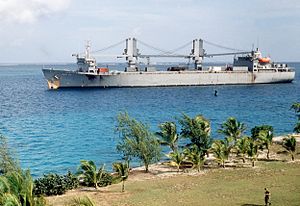- Operation Steel Box
-
Operation Steel Box, also known as Operation Golden Python, was a 1990 joint U.S.-West German operation which moved 100,000 U.S. chemical weapons from Germany to Johnston Atoll.
Contents
Background
At a U.S. Army depot near Clausen, West Germany 100,000 GB and VX filled American chemical munitions were stored.[1] The weapons in this depot were scheduled to be moved due to an agreement between the U.S. and West Germany. The 1986 agreement, between Ronald Reagan and Helmut Kohl, provided for the removal of 155 mm and 8 inch unitary chemical projectiles.[2]
Operation
Operation Steel Box began on July 26, 1990 and ended on September 22, 1990,[3] but the weapons did not reach their final destination until November.[1][4] The move from the storage facility to an intermediate facility at Miesau utilized trucks and trains, civilian contractors, and U.S. and West German military personnel.[2] The weapons were repacked and shipped by truck from their storage facility until they reached the railway in Miesau.[1] The truck transport portion of the mission involved 28 road convoys which delivered the munitions the 30 miles from Clausen to Miesau.[4]
SS Gopher State, one of two ships that carried chemical weapons to Johnston Atoll, pictured here upon arrival at the atoll during Steel Box.
The munitions were carried by special ammunition train from Miesau to the port of Nordenham. The train transport was well publicized and escorted by 80 U.S. and West German military and police vehicles.[1] At the port the munitions were loaded onto two modified ships, the SS Gopher State and the SS Flickertail State,[2] by the Army's Technical Escort Unit.[1] The ships were operated by the U.S. Military Sealift Command,[2] and upon leaving Nordenham they sailed for 46 straight days.[1][2] The ships arrived at Johnston Atoll and on November 18 unloaded the last of their cargo containers.[1]
Reaction and issues
Security and emergency response
Security and emergency response were both concerns during Steel Box. Besides the police and military escort for the trains, the road convoys had restricted airspace overhead.[1] Along the route, emergency response teams were on stand-by.[1] While the ships were inport U.S. Navy EOD Detachments provided underwater hull sweeps to insure limpet mines were not attached to the ships. The 46 day trip at sea was non-stop, with refueling taking place along the route.[2] The ships were also escorted by the U.S. Navy guided missile cruiser USS Bainbridge CGN-25 and USS Truxtun CGN-35.[2] The transport ships avoided the Panama Canal, for security reasons,[1] and took the route around Cape Horn, the tip of South America.[2] There were no reported chemical agent leaks or security breaches during the transport phase of Steel Box.[2]
International reaction
The 1990 shipments of nerve agents from Germany to JACADS caused several South Pacific nations to express unease.[2] At the 1990 South Pacific Forum in Vanuatu, the island nations of the South Pacific indicated that their concern was that the South Pacific would become a toxic waste dumping ground.[5] Other concerns raised included the security of the shipments, which were refueled at sea and escorted by U.S. guided missile destroyers, while they were en route to Johnston Atoll.[2] In Australia, Prime Minister Bob Hawke drew criticism from some of these island nations for his support of the chemical weapons destruction at Johnston Atoll.[6]
See also
- Human experimentation in the United States
- Johnston Atoll Chemical Agent Disposal System
References
- ^ a b c d e f g h i j Mauroni, Albert J. Chemical Demilitarization: Public Policy Aspects, (Google Books), Greenwood Publishing Group, 2003, p. 126–28, (ISBN 027597796X).
- ^ a b c d e f g h i j k Broadus, James M., et al. The Oceans and Environmental Security: Shared U.S. and Russian Perspectives, (Google Books), p. 103, Island Press, 1994, (ISBN 1559632356).
- ^ Junker, Detlef, et al. The United States and Germany in the Era of the Cold War, 1945–1990: A Handbook, (Google Books), Cambridge University Press, 2004, p. 224, (ISBN 052179112X).
- ^ a b Pike, John E. "Operation Golden Python/Operation Steel Box", globalsecurity.org, accessed November 11, 2008.
- ^ Anderson, Ian. "Protests grow over nerve gas disposal", New Scientist, August 11, 1990, accessed November 11, 2008.
- ^ Cooper, Andrew Fenton, et al. Relocating Middle Powers: Australia and Canada in a Changing World Order, (Google Books), UBC Press, 1993, p. 148, (ISBN 0774804505), accessed October 25, 2008.
United States chemical weapons programAgents and chemicals 3-Quinuclidinyl benzilate (BZ) · Chlorine · Methylphosphonyl difluoride (DF) · Phosgene · QL · Sarin (GB) · Sulfur mustard (HD) · VXWeapons Bigeye bomb · M1 chemical mine · M104 155mm Cartridge · M110 155mm Cartridge · M121 155mm Cartridge · M125 bomblet · M134 bomblet · M138 bomblet · M139 bomblet · M2 mortar · M23 chemical mine · M34 cluster bomb · M360 105mm Cartridge · M426 8-inch shell · M43 BZ cluster bomb · M44 generator cluster · M55 rocket · M60 105mm Cartridge · M687 155mm Cartridge · XM-736 8-inch projectile · MC-1 bomb · M47 bomb · Weteye bombOperations and testing Dugway sheep incident · Edgewood Arsenal experiments · Unethical human experimentation in the United States · MKULTRA · Operation CHASE · Operation Davy Jones' Locker · Operation Geranium · Operation LAC · Operation Red Hat · Operation Steel Box · Operation Ranch Hand · Operation Top Hat · Project 112 · Project SHADFacilities Anniston Army Depot · Anniston Chemical Activity · Blue Grass Army Depot · Deseret Chemical Depot · Edgewood Chemical Activity · Hawthorne Army Depot · Johnston Atoll Chemical Agent Disposal System · Newport Chemical Depot · Pine Bluff Chemical Activity · Pueblo Chemical Depot · Tooele Chemical Agent Disposal Facility · Umatilla Chemical DepotUnits and formations Equipment Related topics Categories:- Non-combat military operations involving the United States
- 1990 in Germany
- Chemical warfare
- Non-combat military operations involving Germany
Wikimedia Foundation. 2010.


